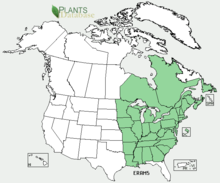Yellow trout lily

Overview
The yellow trout lily (Erythronium americanum) is a common spring ephemeral wildflower that is part of the Liliaceae family and is native to the northeastern United States and eastern Canada. It is a perennial that grows in colonies and blooms between March and May. Each plant produces one nodding bright yellow flower with backwards bending petals and has dark green leaves that are mottled with a purplish-brown coloration. The leaves are where the flower gets its name from: the mottled coloration is said to be similar to the markings on trout. Other names for the yellow trout lily include the American trout lily, eastern trout lily, yellow dogtooth violet, and adder's tongue. [1][2]
Taxonomy
| Kingdom | Phylum | Class | Order | Family | |
|---|---|---|---|---|---|
| Classification | Plantae | Tracheophyta | Liliopsida | Liliales | Liliaceae |

Growth and Reproduction
The natural habitat of yellow trout lilies is deciduous woodland, and they grow best in moist, acidic soil with part sun or dappled sunlight. The plants tend to grow in clumps, forming dense clusters of leaves and flowers, and typically reach 3 to 6 inches in height.[1] The roots grow in the fall, and the flower sprouts, blooms, produces fruit, and dies before canopy trees fully leaf out in the spring.[2][3] The yellow trout lily, while it is immature, will produce one singular basal leaf. When the plant reaches maturity, the yellow trout lily will grow a pair of basal leaves that appear on opposite sides of a newly developed flower stalk.[4] Two versions of the yellow trout lily exist: sterile plants that do not produce flowers but reproduce via runners, and the flowering plants that reproduce sexually via seeds.[5][6] The flowering plants often take roughly 4-5 years after seed dispersal to become mature, and then go dormant again shortly after blooming in the early spring.[7] Each flower contains 4-7 seeds that are typically released in June and July and dispersed by ants, about 40% of which will successfully germinate.[6][8] Interestingly, although yellow is the most common color for pollen in flowering plants, the pollen and anther color of yellow trout lilies can be either red or yellow. This variation has allowed researchers to track pollen distribution from these plants. One 2018 study found that specific pollinators may have preferences for one pollen color over the other.[9] Yellow trout lilies grow slower and have delayed bulb cell maturation at lower temperatures, approximately 15-5 degrees Celsius, and experience slower starch accumulation and a greater sink capacity compared to bulbs grown at temperatures greater than 18 degrees Celsius. Longer leaf spans and larger bulbs seen in yellow trout lilies grown at colder temperatures is a result of improved equilibrium between carbon fixation and capacity and carbohydrate sink strength.[10]

Ecological Significance
The yellow trout lily is an important pollen and food source for many types of insects such as bees, butterflies, flies, and ants. Black bears reportedly eat the corms and white-tailed deer eat the seed capsules, although only to a limited extent. The plant's bulbs are a staple food source for Eastern chipmunks.[2][11] The plant forms a relationship with ants called myrmecochory. The seed of the yellow trout lily grows appendages called elaiosomes that are high in lipid content. The lipid content of the seeds attracts ants. The ants feed on the elaiosomes and disperse the seeds for plant reproduction.[4][12] It also plays a role in soil nutrient cycling and retention, and about 75% of the roots are infected by arbuscular mycorrhizae, which is unusual for a spring ephemeral.[3][11] Mycorrhizae decrease root growth during the winter and cost the yellow trout lily carbohydrate reserves, however, during the spring, mycorrhizal fungi can double the annual growth rate of the lily compared to growth without mycorrhizae. [13]
References
- ↑ 1.0 1.1 University of Texas. (19 March 2019). Erythronium americanum. https://www.wildflower.org/plants/result.php?id_plant=eram5
- ↑ 2.0 2.1 2.2 Wild Adirondacks. Wildflowers of the Adirondacks: Trout Lily (Erythronium americanum). https://wildadirondacks.org/adirondack-wildflowers-trout-lily-erythronium-americanum.html
- ↑ 3.0 3.1 Lapointe, L., & Molard, J. (1997). Costs and benefits of mycorrhizal infection in a spring ephemeral, Erythronium americanum. The New Phytologist, 135(3), 491-500.
- ↑ 4.0 4.1 The Morton Arboretum. (26 December 2024). Yellow Trout Lily. https://mortonarb.org/plant-and-protect/trees-and-plants/yellow-trout-lily/#more-information
- ↑ Holland, P. G. (1980). Transplant experiments with trout lily at Mont St Hilaire, Quebec. Journal of Biogeography, 261-267.
- ↑ 6.0 6.1 Tessier, J. T. (2012). Methods of belowground movement in Erythronium americanum. Northeastern Naturalist, 19(sp6), 77-88.
- ↑ North Carolina State Cooperative Extension Plant Toolbox. "Erythronium americanum". https://plants.ces.ncsu.edu/plants/erythronium-americanum/
- ↑ Muller, R. N. (1978). The phenology, growth and ecosystem dynamics of Erythronium americanum in the northern hardwood forest. Ecological Monographs, 48(1), 1-20.
- ↑ Austen, E. J., Lin, S. Y., & Forrest, J. R. (2018). On the ecological significance of pollen color: a case study in American trout lily (Erythronium americanum). Ecology, 99(4), 926-937.
- ↑ Anthony Gandin, Sylvain Gutjahr, Pierre Dizengremel, Line Lapointe, Source–sink imbalance increases with growth temperature in the spring geophyte Erythronium americanum, Journal of Experimental Botany, Volume 62, Issue 10, June 2011, Pages 3467–3479, https://doi.org/10.1093/jxb/err020
- ↑ 11.0 11.1 Tessier, J. T. (2022). Severe frost but not shade could limit the future growing season of Erythronium americanum. Botany, 100(3), 275-282.
- ↑ Xerces Society for Invertebrate Conservation. (11 July 2024). Myrmecochory: How Ants Shape Plant Communities. https://www.xerces.org/blog/myrmecochory-how-ants-shape-plant-communities#:~:text=This%20seed%2Dcarrying%20partnership%20between,their%20exterior%20called%20an%20elaiosome.
- ↑ Lapointe, L. and Molard, J. (1997), Costs and benefits of mycorrhizal infection in a spring ephemeral, Erythronium americanum. New Phytologist, 135: 491-500. https://doi.org/10.1046/j.1469-8137.1997.00672.x